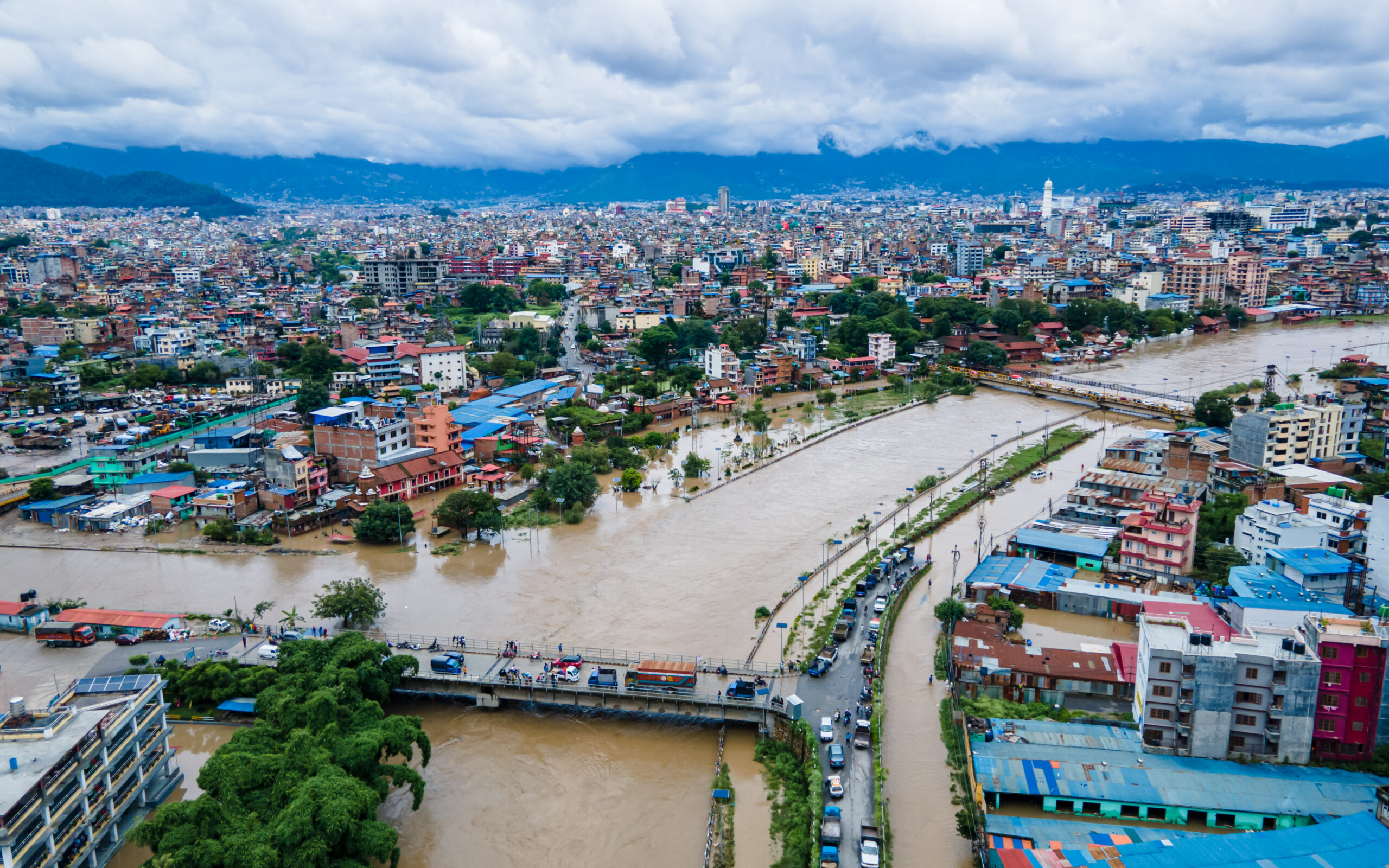Nepal, a country prone to natural disasters, faces significant challenges in its disaster response and recovery efforts. Disasters are not new to Nepal and its population; the nation has faced several major disasters in the past decades, highlighting its vulnerability to natural hazards due to its geographical and climatic conditions.
The 2015 Gorkha Earthquake was one of the most devastating events in the nation’s history that killed nearly 9,000 people, injured tens of thousands, and left vast numbers of people homeless. The magnitude of the earthquake was such that it also triggered landslides and avalanches, including one on Mount Everest, which killed 22 climbers. Moreover, in recent years, Nepal has been hit by severe floods and landslides worsened by monsoon rains. These recent natural disasters have resulted in 215 deaths, 31 people missing, and have disrupted transportation links. Critical infrastructure like schools and highways has been damaged, and communities have been displaced. These events have once again highlighted the pressing issues faced by the region. The capital, Kathmandu region, is the most affected after recent floods and landslides.
Despite years of experience and ongoing international assistance, Nepal’s ability to effectively manage disaster situations remains hindered by capacity constraints, coordination gaps, community involvement and systemic inefficiencies. This blog briefly explains these issues.
1. Lessons from the 2015 Earthquake
The 2015 Gorkha earthquake offers critical insights into Nepal’s disaster response and recovery challenges. Nearly a decade later, the country is still grappling with the long-term effects of the disaster. While substantial international funding was pledged to support the recovery, including commitments of around $4.1 billion, the actual disbursement and utilization of these funds have been slow. Bureaucratic hurdles, lack of political commitments, and coordination between national and local agencies have delayed reconstruction efforts, leaving many communities without adequate housing or infrastructure.
In addition, local governments in Nepal were only recently empowered after the federal restructuring under the 2015 Constitution. This delay meant that local authorities had little experience or infrastructure to handle such large-scale recovery efforts. The absence of effective community coordination also hindered the process, as many affected areas relied on non-governmental organizations (NGOs) and local volunteers, leading to fragmented recovery initiatives.
1.1 Capacity Limitations
A major challenge in Nepal’s disaster management framework is the lack of sufficient capacity. Nepal has limited resources, including a shortage of trained personnel, emergency equipment, and infrastructure. Mountainous terrain, remote communities, and underdeveloped infrastructure significantly hinder the authorities’ ability to respond swiftly to emergencies.
Although the government has taken steps to improve its disaster response mechanisms, including forming the National Disaster Risk Reduction and Management Authority (NDRRMA), these measures often fall short due to inadequate funding and training. Rescue operations in remote and mountainous areas are particularly difficult, as many regions lack basic infrastructure like roads and communication networks, severely increasing response times. Moreover, local governments, which should be at the forefront of initial disaster response, often lack the tools and training necessary to coordinate effectively.
1.2 Coordination Issues
Nepal’s disaster response is often complicated by poor coordination among various stakeholders. Government agencies, international donors, and NGOs frequently operate in silos, with little communication or shared strategy. This lack of coordination delays emergency response efforts and complicates long-term recovery. In the case of the recent floods and landslides, many survivors reported that aid was slow to arrive, and relief efforts were disorganized.
Furthermore, Nepal’s complex geographical landscape presents additional logistical challenges. Remote areas are difficult to access, and emergency services often struggle to reach communities in need. The lack of a robust early warning system exacerbates these challenges, leaving many vulnerable populations unprepared for impending disasters.
1.3 Funding and Community Involvement
Funding remains a critical bottleneck in Nepal’s disaster management efforts. While international donors have been generous in the aftermath of major disasters like the 2015 earthquake, the flow of funds is often slowed by bureaucratic inefficiencies and corruption. Additionally, there is a lack of focus on community involvement in disaster preparedness and recovery. Local communities are often side-lined in decision-making processes, despite being the most affected by these disasters. Without their input, recovery efforts fail to address the unique needs and vulnerabilities of different regions.
1.4 Unawareness of the Threat
The unawareness of flood risks, coupled with the lack of adequate infrastructure, has left many communities in Nepal vulnerable to the impacts of such disasters. Moving forward, focusing on disaster preparedness, education, and improving early warning systems are essential to mitigate the devastating effects of floods in the future.
The recent floods in Nepal have highlighted several key lessons that need to be considered for future disaster preparedness, mitigation, and recovery efforts. These lessons underscore the need for proactive and coordinated approaches in addressing flood risks and minimizing the impact on lives and property.
2. Moving Forward
To improve disaster response and recovery, Nepal must focus on building local capacity, particularly at the municipal and village levels. Local governments must be empowered with the tools and training to coordinate effectively with national agencies and international organizations. Moreover, improving stakeholder coordination and involving communities in decision-making will be key to ensuring a more resilient recovery framework. Strengthening early warning systems, improving infrastructure in remote areas, and ensuring transparent use of funding will also be essential in addressing the growing challenges posed by natural disasters in Nepal.
2.1 Importance of Early Warning Systems
One of the critical lessons from the recent floods is the need for effective early warning systems. While some areas received warnings, many regions lacked the infrastructure or communication channels to relay information quickly to residents. Improving flood forecasting and ensuring timely dissemination of information through accessible channels like mobile alerts, radios, and community networks is crucial for saving lives.
2.2 Preparedness and Community Engagement
Local communities in flood-prone areas need to be better prepared to respond to flooding. Preparedness measures, such as flood drills, evacuation plans, and the establishment of safe shelters, can significantly reduce the loss of life. More community-based disaster management programs should be implemented to educate and empower local populations on how to act in emergencies.
2.3 Improving Infrastructure Resilience
The recent floods revealed the vulnerability of infrastructure, including roads, bridges, and buildings, which were either washed away or heavily damaged. Moving forward, Nepal needs to invest in resilient infrastructure that can withstand the impact of floods. This includes constructing flood barriers, improving drainage systems, and ensuring that future developments are flood-resistant, especially in vulnerable regions like the Terai.
3. Conclusion
In conclusion, improving Nepal’s disaster response and recovery require a multifaceted approach, focusing on building local capacity and empowering municipalities with the tools for better coordination with national and international agencies. Strengthening early warning systems, involving communities in preparedness efforts, and investing in resilient infrastructure are essential. Transparent use of funds and effective stakeholder collaboration will help ensure a sustainable recovery framework, addressing the unique challenges posed by natural disasters in Nepal.
Table of Contents
Toggle


